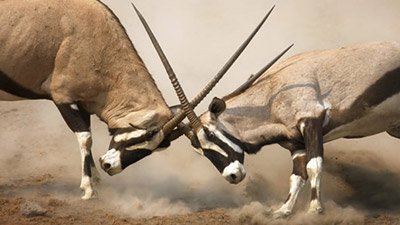
Evolution or Adaptation?
Mutation Leads to Better Survival in Beach Mice
An article in the July 24, 2006 Washington Post refers to a March 2006 PLoS Biology article that suggests that humans are currently undergoing evolution.
According to a recent news article released by Howard Hughes Medical Institute (HHMI)1 based on an article released in the July 7th Science magazine,2 a single mutation in mouse DNA is a major contributor to the light coat color seen in beach mice leading to better survival in a sandy environment. The news article states that this “provides evidence that evolution can occur in big leaps.”3
Beach Mice and Coat Color
Beach mice, Peromyscus polionotus, vary widely in color. The particular mice studied in this research live on the Gulf coast of Florida’s barrier islands. It had been noted in previous research that some mice were very light colored but the underlying molecular mechanism was not known. The researchers found that these mice have a mutation in the melanocortin-1 receptor gene (Mc1r).4 A single base change in the DNA led to an amino acid change in the protein; an arginine was replaced with a cysteine. Arginine is a charged amino acid and cysteine is not, and cysteine can form special disulfide bonds in the protein that arginine cannot. This causes the two amino acids to have a different physical behavior in a protein, thereby probably altering the structure of the mutant protein (although this was not directly addressed in the Science article). As a result, the mutant Mc1r protein has a reduced affinity for the melanocyte stimulating hormone (MSH) that binds to it.5 This receptor–hormone interaction is important in mammals for the production of melanin, which is responsible for pigmentation. (In humans, a dysfunctional Mc1r gene can be responsible for red hair and fair skin.) It would thus be assumed that since this interaction is weakened in the light-colored mice, the mice’s melanin production is decreased, resulting in the lighter-colored fur.
Evolution or Adaptation
Directional evolution cannot be achieved by reduction/elimination of pre-existing genetic information.
To creationists, the authors’ explanations of their findings seem paradoxical. “This is a striking example of how protein-coding changes can play a role in adaptation and divergence in population, and ultimately species.”6 I agree. “Identification of a single mutation that contributes to the color change that has arisen in these animals argues for a model of evolution in which populations diverge in big steps”7 (in a short time, as the researchers believe this happened in less than 6,000 years). Hoekstra contrasts this with the popular evolution mechanism of “small changes accumulated over long periods of time”.8 I disagree. Once again, adaptation / natural selection is being extrapolated to explain molecules-to-man evolution. I also question whether a change of coat color is really relevant to this form of evolution. If the mice had a mutation that somehow (even though a mutation could never do this) allowed the growth of a useful appendage, that might provide some movement in the right direction! What scientists must demonstrate for molecules-to-man evolution to be plausible is the genetic mechanism to account for the origin of the melanin gene, pigmentation, etc. Clearly a mutation in a pigmentation gene causing less of the pigment to be made does not provide that kind of example. Directional evolution cannot be achieved by reduction/elimination of pre-existing genetic information.
Real Problems
A major surprise for the researchers was that the mutation they found would had to have occurred fairly rapidly, as the islands on which P. polionotus lives are considered to be less than 6,000 years old.2 This is no surprise to creationists, as such processes (and perhaps other factors affecting the genome) would have occurred rapidly after the Flood, producing variation within the animal kinds (in addition to their already created diversity). Such effects are largely responsible for generating the tremendous diversity seen in the living world. In addition, there are many other modern-day examples of adaptation that has occurred quickly.
Another important point is that most mutations in DNA are not selectable9 even though they seem to be making a big deal out of one that is. In order for a mutation to be selected for or against, it must make some change in the organism at the phenotypic, whole-organism level. The change must be large enough to give the organism an increased or decreased fitness in its environment. Most mutations in the DNA are either silent (leading to no change at the phenotypic level), lethal (leading to death of the organism), or slightly deleterious (not altering phenotype sufficiently to be specifically detected by any selection process). It is unusual to find one mutation that leads directly to a selectable trait in a higher organism (although this does happen commonly in bacteria, as is seen in antibiotic-resistant bacteria).10
The mutation, although beneficial to the beach mice, still leads to a loss of genetic information. The mutant Mc1r protein does not bind as well to MSH and thus, the mice have decreased melanin production leading to lighter fur color. Although this is an advantage in the beach environment, it may not be an advantage should the mice change geographic location, e.g., to a forest, where darker fur color would be preferred. In addition, molecules-to-man evolution must account for the origin of melanin and pigmentation, not the loss of it. Mutations that decrease melanin production and cause lighter pigmentation are contrary to directional evolution but fully consistent with the effects of living in a post-Fall world. Evolutionists tend to assume that anything that is positively selected is “evolution” in action, and that is simply not the case. The news article also states that because this mutation was found in a protein-coding region of the DNA, the differences between humans and chimps and other organisms may not be in the regulatory regions as suspected.11 This is a big assumption based on the discovery of only one mutation. The affectionately called “junk” DNA is being discovered as highly functional (including being involved in controlling protein expression), to the point that eventually all of our genome may be found to be greater than 100% functional!12
Another striking reality is that light-colored mice on the Atlantic coast have a different mechanism for developing their coat color, as they do not possess a mutation in the melanocortin-1 receptor.13 So even though the mice share a similar coloration they have different mechanisms for achieving it. The origin and development of one mechanism for coat color variation is difficult enough for evolution to explain—try explaining two!
Conclusion
From a creationist perspective, this research provides us with yet another example of a beneficial outcome of a mutation in a given environment allowing an organism a selectable advantage. Mutations lead to loss of information, and while the organism may be more well suited for its current environment, it may have lost the ability to adapt to other environments. The mutation described in this Science paper does not address the origin of the melanin gene or pigmentation, only the loss of them, thus it is not relevant mutation to the discussion of molecules-to-man evolution.
Footnotes
- Jim Keeley, “An Evolution Sagan: Beach Mice Mutate and Survive,” Howard Huges Medical Institute, July 7, 2006, http://www.hhmi.org/news/evolution-saga-beach-mice-mutate-and-survive.
- Hopi Hoekstra et al., “A Single Amino Acid Mutation Contributes to Adaptive Beach Mouse Color Pattern,” Science 313, no. 5783 (July 7, 2006): 101–104, doi:10.1126/science.1126121.
- Ibid.
- Ibid.
- Ibid.
- Ibid.
- Ibid.
- Ibid.
- J. C. Sanford, Genetic Entropy and the Mystery of the Genome, Ivan Press, 2006.
- Ibid.
- Ibid.
- Ibid.
- Ibid.
Recommended Resources

Answers in Genesis is an apologetics ministry, dedicated to helping Christians defend their faith and proclaim the good news of Jesus Christ.
- Customer Service 800.778.3390
- Available Monday–Friday | 9 AM–5 PM ET
- © 2025 Answers in Genesis



